Data Integration Steps
Data integration is a crucial process in modern business operations, enabling seamless access and analysis of data from diverse sources. This article outlines the essential steps involved in integrating data, from initial data collection to final data harmonization. By following these steps, organizations can ensure data consistency, improve decision-making, and drive operational efficiency.
Data Integration as a Framework
Data integration as a framework involves a systematic approach to combining data from different sources into a single, unified view. This framework ensures that data is accurately and efficiently merged, providing a consistent and comprehensive dataset for analysis and decision-making.
- Data Collection: Gathering data from various sources.
- Data Transformation: Converting data into a common format.
- Data Cleansing: Removing inconsistencies and errors.
- Data Loading: Importing the cleaned data into a data warehouse or repository.
- Data Monitoring: Continuously checking data quality and integrity.
Using tools like ApiX-Drive can significantly simplify the data integration process. ApiX-Drive allows seamless integration of multiple data sources, automating data collection and transformation tasks. This not only saves time but also ensures that the data is always up-to-date and reliable, making it an invaluable asset for any data integration framework.
Data Integration as a Process

Data integration is a structured process that involves combining data from various sources into a unified view, enabling more comprehensive analysis and decision-making. The process typically begins with data extraction, where information is gathered from disparate systems such as databases, cloud services, and applications. Following extraction, the data undergoes transformation, which includes cleansing, normalization, and enrichment to ensure consistency and accuracy. The final step is loading, where the refined data is stored in a central repository like a data warehouse or data lake, making it readily accessible for analysis and reporting.
To streamline and automate these steps, various tools and platforms are available, one of which is ApiX-Drive. This service simplifies the integration process by providing a user-friendly interface that allows for easy configuration of data flows between different systems. ApiX-Drive supports a wide range of applications and databases, making it a versatile solution for businesses looking to enhance their data integration capabilities. By leveraging such tools, organizations can ensure that their data integration processes are efficient, reliable, and scalable, ultimately leading to better data-driven insights and outcomes.
Data Integration Techniques

Data integration is a critical process for organizations aiming to unify disparate data sources into a cohesive, usable format. There are several techniques to achieve effective data integration, each with its own set of benefits and challenges.
- ETL (Extract, Transform, Load): This traditional method involves extracting data from various sources, transforming it into a suitable format, and loading it into a central repository.
- ELT (Extract, Load, Transform): Similar to ETL, but the transformation occurs after loading the data into the target system, often used with cloud-based data warehouses.
- Data Virtualization: This technique allows real-time data integration without moving the data, providing a unified view through a virtual layer.
- API Integration: Using APIs to connect different systems and applications, enabling seamless data exchange. Tools like ApiX-Drive simplify this process by automating data flows between various platforms.
- Data Replication: Involves copying data from one system to another, ensuring consistency and availability across different databases and applications.
Choosing the right data integration technique depends on the specific needs and infrastructure of an organization. Tools like ApiX-Drive can significantly streamline the integration process, offering automated solutions that reduce manual effort and improve data accuracy.
Challenges and Benefits of Data Integration

Integrating data from various sources presents numerous challenges. One of the primary difficulties is ensuring data quality and consistency across different systems. Data from disparate sources might have different formats, structures, and standards, making it complex to harmonize and integrate seamlessly. Additionally, data security and privacy concerns are paramount, as integrating sensitive information can expose vulnerabilities.
Despite these challenges, the benefits of data integration are substantial. Efficient data integration allows for more comprehensive data analysis, leading to better-informed decision-making. It also enhances operational efficiency by automating data workflows and reducing manual data entry, thus minimizing errors and saving time.
- Improved data quality and consistency
- Enhanced decision-making capabilities
- Increased operational efficiency
- Reduced manual data entry errors
- Better data security and compliance
Tools like ApiX-Drive can significantly simplify the data integration process. ApiX-Drive offers a user-friendly platform that allows businesses to connect various applications and automate data workflows without needing extensive technical expertise. This not only streamlines the integration process but also ensures that data is consistently accurate and up-to-date.
Real-World Use Cases of Data Integration
Data integration is crucial in various industries, enabling seamless data flow and improving decision-making processes. In healthcare, integrating patient records from multiple sources ensures accurate and comprehensive patient care. Hospitals and clinics can consolidate data from different departments, such as radiology, lab results, and patient history, to provide a holistic view of a patient's health, leading to better diagnosis and treatment plans.
In the e-commerce sector, data integration helps businesses streamline operations by connecting various platforms like inventory management, customer relationship management (CRM), and sales channels. For instance, ApiX-Drive facilitates the integration of diverse systems, allowing online retailers to automate data transfer between their e-commerce platform and other tools. This ensures real-time inventory updates, personalized marketing campaigns, and enhanced customer experiences. By leveraging such integrations, companies can optimize their workflows, reduce manual errors, and ultimately increase their efficiency and profitability.
FAQ
What is data integration?
What are the key steps in data integration?
Why is data transformation important in the integration process?
How can I automate the data integration process?
What challenges might I face during data integration?
Time is the most valuable resource for business today. Almost half of it is wasted on routine tasks. Your employees are constantly forced to perform monotonous tasks that are difficult to classify as important and specialized. You can leave everything as it is by hiring additional employees, or you can automate most of the business processes using the ApiX-Drive online connector to get rid of unnecessary time and money expenses once and for all. The choice is yours!

